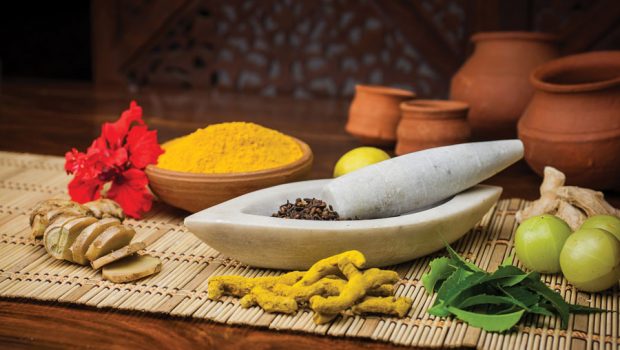Ayurvedic Cooking
Ancient System Restores Balance
by April Thompson
In Ayurveda, food is medicine,” says Susan Weis-Bohlen, the Reisterstown, Maryland, instructor and author of Ayurveda Beginner’s Guide: Essential Ayurvedic Principles and Practices to Balance and Heal Naturally. “How we feed ourselves is the first line of disease prevention and longevity.”
First developed in India some 5,000 years ago, Ayurveda is one of the world’s oldest medical systems. It works to rebalance mental and physical health in coordination with mind-body energy types called doshas. The primary ones—Vata, Pitta and Kapha—correlate to the five elements of space, air, fire, earth and water, and can fluctuate over time.
An Ayurvedic diet can help address dosha imbalances and optimize health and well-being. New York City chef, restauranteur and author Divya Alter embraced Ayurveda while suffering from an autoimmune disorder that conventional medicine couldn’t cure. “Food was instrumental to my healing,” she says.
Eating in Season
“Ayurveda is about living in harmony. Eating seasonally and locally, you not only get the most nourishment, but also rekindle your relationship to food and the environment,” says Nishita Shah, of The Ayurvedic Institute, in Albuquerque.
“In Ayurveda, we look to seasons to determine what to eat based on what is naturally available, like eating light juicy fruits in summer rather than the heavy root vegetables abundant in winter,” notes Weis-Bohlen.
Spices and herbs have powerful healing properties that can be combined in different ways to balance doshas in tune with the seasons. “In winter, use warming spices like ginger, cinnamon or chilies, and in summer, season with cooling spices like coriander and fennel, or fresh herbs like cilantro,” says Alter.
Ayurvedic Prep Tips
Proper combination and selection of ingredients are a critical component of Ayurve- da, according to Alter, author of What to Eat for How You Feel: The New Ayurvedic Kitchen. She says, “Well-prepared food is easy to digest and protects prana—the food’s living force or energy—so it can nourish and energize.”
Ayurveda also focuses on the “six tastes” ideally present in every dish: sweet, sour, salty, astringent, bitter and pungent.
“Western cuisine has a strong salty and sweet bias. Health issues arise from an imbalanced palate,” says Shah.
Alter adjusts taste profiles according to the season and the individual’s dosha. “Bitter foods can be very cleansing and help eliminate winter sluggishness. More pungent foods are good in the spring, when the body may feel congested and heavy after winter,” she says.
To address diners’ differing doshas at her restaurant, Divya’s Kitchen, Alter focuses on seasonal dishes that incorporate all six tastes. “By definition, these are tri-doshic foods which can balance all three dosha types.”
Good tri-doshic foods include asparagus in spring, berries in summer and root vegetables in winter. “Cooked leafy greens can also be tri-doshic,” says Alter, adding that spices can tweak the natural dosha effect of a given food.
Ancient Cooking for Modern Lifestyles
Ayurveda’s rules of the kitchen—such as avoiding cold, raw, processed or microwaved foods, not combining fruits with other foods, and making lunch the heaviest meal of the day—can run counter to the typical Western diet, but with time, Ayurvedic cooking can become intuitive.
Ayurvedic meals don’t need to be complicated or challenging to prepare. “A simple apple or plain rice can nourish us,” says Shah. One of Alter’s favorite recipes is an apple or pear stewed with cloves, prepared and eaten first thing in the morning to stimulate the digestive system. Plain almonds are another good protein snack, especially in aiding digestion when soaked and peeled, she advises.
A “Buddha bowl” packed with colorful, sautéed vegetables, lentils and a grain like quinoa, barley or millet makes for a simple, nourishing, well-balanced meal, says Shah. “I try to add just enough spice to enhance the flavor, while still being able to taste the sweetness of a carrot or the bitterness of chard.”
A cook’s mindset is as important as the meal itself, say Ayurvedic practitioners. Alter believes mindfulness while cooking and eating not only enhances our experience, but also our digestion.
Ayurvedic cooking should be fun, ignite curiosity and taste great—not feel restrictive or lack flavor, says Shah. “Food should bring joy, and bring us back in tune with our bodies. Our bodies are smart and will tell us what they need.”
April Thompson is a freelance writer in Washington, D.C. Connect at AprilWrites.com.












